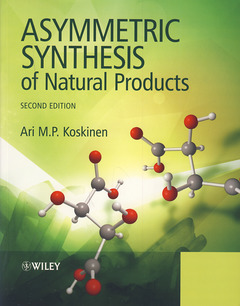Description
Asymmetric synthesis of natural products (Paper) (2nd Ed.)
Author: Koskinen Ari M. P.
Language: English
Subject for Asymmetric synthesis of natural products (Paper):
Approximative price 147.17 €
In Print (Delivery period: 12 days).
Add to cart304 p. · 19.4x25.2 cm · Hardback
Description
/li>Contents
/li>Biography
/li>
List of Common Abbreviations ix
Preface to the First Edition xiii
Preface to the Second Edition xv
1 Introduction 1
1.1 Some properties of natural products 4
1.2 Natural products as drugs 7
1.3 Structures of natural products 10
1.4 Asymmetric synthesis of natural products 15
1.5 Synthetic organic chemistry 17
References 202
2 Chirality, Topology, and Asymmetric Synthesis 23
2.1 The need for enantiopure compounds 34
2.2 Determination of enantiomeric purity 38
2.3 Chirality and thermodynamic principles of asymmetric induction 42
2.4 Methods for obtaining chiral compounds 44
References 523
3 Asymmetric Synthesis 55
3.1 Allylic strain 55
3.2 Reactions of the carbonyl group 59
3.2.1 Nucleophilic additions on the carbonyl carbon 59
3.2.2 Reactions at the
3.2.3 Reactions at the
3.2.4 Reactions of olefins 99
3.3 Oxidation 99
3.3.1 Asymmetric dihydroxylation 100
3.3.2 Asymmetric epoxidation 103
References 108
4 Sugars 115
4.1 Monosaccharides 116
4.1.1 Aldoses and ketoses 116
4.1.2 Deoxy sugars 122
4.1.3 Amino sugars 122
4.1.4 Sugar alcohols 125
4.1.5 Acidic sugars 125
4.2 Polysaccharides 127
4.3 Glycoproteins and proteoglycans 131
4.4 Glycolipids 134
4.5 Sugar antibiotics 134
4.6 Cyclitols 138
References 142
5 Amino Acids, Peptides, and Proteins 145
5.1 Amino acids 145
5.2 Peptides and proteins 149
5.3 Enzymes and receptors 153
5.4 Chemical modifications of peptides 154
5.5 Biosynthesis of amino acids 156
5.6 Asymmetric synthesis of amino acids 160
5.6.1 α-Alkylation 162
5.6.2 Amination of ester enolates 167
5.6.3 Catalytic hydrogenation 169
5.6.4 Miscellaneous 170
5.6.5 Pepstatins 171
References 173
6 Nucleosides, Nucleotides, and Nucleic Acids 175
References 184
7 Polyketides 187
7.1 Biosynthesis 187
7.2 Fatty acids 190
7.2.1 Prostaglandins, thromboxanes, and leukotrienes 191
7.2.2 Sphingolipids 196
7.3 Polypropionates 200
7.3.1 Polyether antibiotics 200
7.3.2 Macrolides 201
7.3.3 Spiroketals 209
7.4 Aromatic polyketides 213
References 215
8 Terpenes 219
8.1 Terpenes 221
8.1.1 Monoterpenes 221
8.1.2 Sesquiterpenes 223
8.1.3 Diterpenes 228
8.1.4 Higher Terpenes 230
8.2 Carotenoids 234
8.3 Steroids 235
8.3.1 Biosynthesis of steroids 240
8.3.2 Asymmetric synthesis of steroids 242
References 244
9 Shikimic Acid Derivatives 247
9.1 Case synthesis: Oseltamivir 251
References 254
10 Alkaloids 257
10.1 Heterocyclic alkaloids 258
10.1.1 Indole alkaloids 259
10.1.2 Pyrrolidine and tropane alkaloids 271
10.1.3 Quinoline and isoquinoline alkaloids 273
10.1.4 Izidine alkaloids 279
10.2 Alkaloids with exocyclic nitrogen 282
10.3 Polyamine alkaloids 283
10.4 Peptide alkaloids 283
10.5 Terpene alkaloids 284
References 285
Index 289
Professor Koskinen has held academic appointments at the University of Sussex and University of Oulu , and transferred to his current position at Aalto University in 1999 as Professor of Organic Chemistry. He also holds docentships at the Universities of Helsinki and Turku. Professor Koskinen is a member of the Finnish Academy of Sciences and Letters, the Novartis Foundation International Scientific Advisory Panel, the Scientific Advisory Board of the Finnish Chemical Industry Federation, European Society for Combinatorial Sciences, on the management committees of EU-research programs, and is a founding member of the European Chemical Society. He is the author or co-author of some 160 publications, 15 patents and three books.




